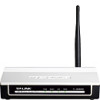TP-Link TL-WA500G User Guide - Page 26
Enable SSID Broadcast, Universal Repeater - bridge
 |
UPC - 845973051105
View all TP-Link TL-WA500G manuals
Add to My Manuals
Save this manual to your list of manuals |
Page 26 highlights
TL-WA500G 54M Wireless Access Point User Guide ) Note: AP provides five operational modes: Access Point, Client, Repeater, Bridge (point to point), Bridge (point to Multi-point). ¾ Access Point - The Access Point mode allows wireless stations including AP clients to access. • Enable SSID Broadcast - Checking the Enable SSID Broadcast box will enable Wireless Access Point to broadcast its name (SSID). ¾ Client - The Client mode allows one or more remote LANs to connect a central LAN, and thus creating an extended virtual LAN. In this way, any station of the Remote LAN can successfully communicate with any station of the central LAN, as if all of them belong to the same physical LAN. Wireless Stations can't associate with AP Clients. • Enable WDS - Checking the Enable WDS (Wireless Distribution System) box will forward all traffic from wired networks in the format of WDS frames consist of four address fields. The AP client can connect to AP with WDS enabled or disabled. If WDS is disabled, three address frames are used. If your AP supports WDS well, please select the option. • SSID - Enter the SSID of AP that you want to access. If you select the radio button before SSID, the AP client will connect to AP according to SSID. • MAC of AP - Enter the MAC address of AP that you want to access. If you select the radio button before MAC of AP, the AP client will connect to AP according to MAC address. ¾ Repeater - The wireless Repeater mode allows the AP with its own BSS and with WDS enabled to relay data to a root AP, to which it is associated. The wireless repeater relays signal between its stations and the root AP for greater wireless range. Please input the MAC address of root AP in the field of MAC of AP. ¾ Universal Repeater - The Universal Repeater mode allows APs without WDS function to be communicated with. ) Note: If the available AP can't support with WDS, you may select Client mode without WDS or Universal Repeater mode to associate with the AP. Here is an example of how to configure wireless repeater. 1. Configure the Operating Mode of the TL-WA500G Access Points. • Configure AP1 on LAN Segment 1 in Access Point mode. • Configure AP2 in Repeater mode with the MAC address of its root AP (AP1). • Configure AP3 in Repeater mode with the MAC address of its root AP (AP2). 19















